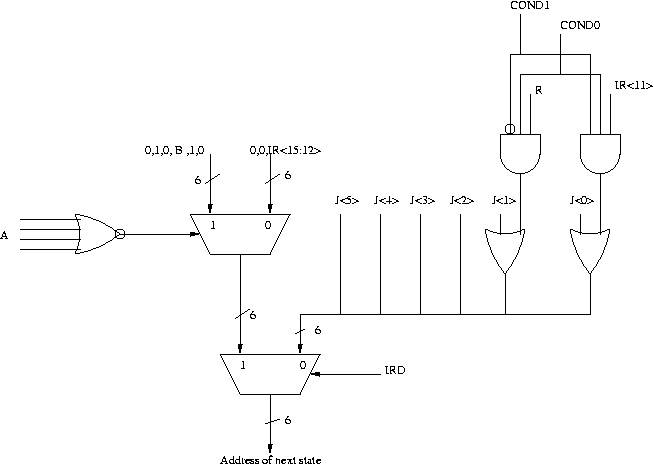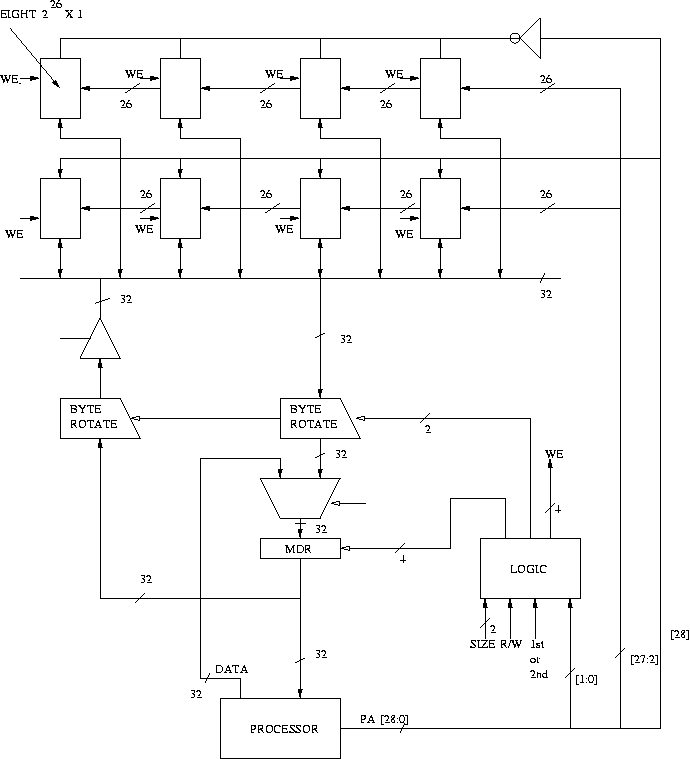A. What does the following LC-3b program do? How many cycles does each instruction take to execute on the LC-3b microarchitecture described in Appendix C? How many cycles does the entire program take to execute? (Assume that a memory access takes 5 cycles)
.ORIG x4000 AND R1, R1, #0 ADD R1, R1, #5 LSHF R1, R1, #12 LDW R2, R1, #0 RSHFL R3, R2, #8 LSHF R4, R2, #8 ADD R2, R3, R4 STW R2, R1, #1 HALT .END
B. What does the following LC-3b program do? How many cycles does it take to execute? (Assume that a memory access takes 5 cycles)
.ORIG x4000 AND R1, R1, #0 ADD R1, R1, #5 LSHF R1, R1, #12 LDB R2, R1, #0 STB R2, R1, #3 LDB R2, R1, #1 STB R2, R1, #2 HALT .END
State 18: MAR <- PC, PC <- PC + 2
State 33: MDR <- M
State 35: IR <- MDR
Which of the following different organizations would still work
correctly, why or why not? (Assume that a memory access takes five
cycles).
State 18: PC <- PC + 2 State 33: MAR <- PC, MDR <-M State 35: IR <- MDR
State 18: MAR <- PC State 33: PC <- PC + 2, MDR <-M State 35: IR <- MDR
State 18: MAR <- PC State 33: MDR <- M State 35: IR <- MDR, PC <- PC + 2
2.Suppose we want to get rid of the BEN register altogether. Can this be done? If so, explain how. If not, why not? Is it a good idea? Explain.
3.Suppose we took this further and got rid of state 0. The figure below shows a modified microsequencer. What is the 4-bit signal denoted as A in the figure? What is the 1-bit signal denoted as B?

Assembler format for PUSH:
PUSH SR
Encoding:

Operation:
R6 = R6 - 2;
MEM[R6] = SR;
Description:
SR is pushed onto the stack.
Example:
PUSH R1
Assembler format for POP:
POP DR
Encoding:

Operation:
DR = MEM[R6];
setcc(DR);
R6 = R6 + 2;
Description:
Top word is popped off the stack and loaded into DR. Condition codes
are set based on the value loaded into DR.
Example:
POP R1
Your job:
A. Append the current state machine for supporting PUSH and POP
instructions.
B. Will the current datapath support the above state machine? If
not, then draw the new datapath to implement the above state
machine. Show the new structures you added to support PUSH and POP
operations.
C. Are there any additional control signals needed for the new
states? If so, what are they? Give the values of these new control
signals in each new state you added and show them clearly in your
datapath figure for Part B.
D. How many cycles will each of the following set of instructions
take to execute?
1. PUSH R4
2. ADD R6, R6, # -2
STW R4,
R6, #0
3. POP R0
4. LDW R0, R6, #0
ADD R6, R6,
#2
- 16-bit address in MAR. This signal can take the following values: xFE00, xFE02, xFE04, xFE06, and OTHER (any other address between x0000 and xFDFF).
- 1-bit control signal R.W. The access is a read access if this signal is R, write access if it is W.
- 1-bit control signal MIO.EN. If this signal is 1, a memory or I/O access should be performed in this cycle.
The logic has five outputs:
- 1-bit MEM.EN signal. Memory is enabled if this signal is 1.
- 2-bit select signal for INMUX. This signal can take the following values: KBDR, KBSR, DSR, MEMORY.
- 1-bit LD.KBSR signal. KBSR will be load-enabled at the end of the current cycle if this signal is 1.
- 1-bit LD.DDR signal. DDR will be load-enabled at the end of the current cycle if this signal is 1.
- 1-bit LD.DSR signal. DSR will be load-enabled at the end of the current cycle if this signal is 1.
Your task is to draw the truth table for this Address Control Logic. Mark don't care values with X in your truth table. Use the conventions described above to denote the values of inputs and outputs. Please read Section C.6 in Appendix C on Memory-mapped I/O before answering this question. Also, refer to Appendix A to find out the addresses of device registers.
8KB page size 3 levels of access (similar to VAX architecture discussed in class): none (-) read (R) write (W) 4 privilege levels (again similar to VAX architecture discussed in class): user (U) supervisor (S) executive (E) kernel (K) page replacement using a reference bit for each pageHow many pages are there in virtual memory? How many frames are there in physical memory? What is the minimum number of bits required to encode all the valid combinations of privilege levels and access levels? Show which access level/privilege level combinations are valid and which are invalid.
Show a PTE for this memory, and specify the number of bits required for each field in the PTE. Finally, describe how a 28-bit virtual address is translated into a 26-bit physical address.
You will need to know the contents of P0BR: x8AC40000 and SBR: x000C8000.
You will also need to know the contents of the following physical memory locations:
x1EBA6EF0: x80000A72Some intermediate questions to help you:
x0022D958: x800F5D37
- What virtual page of P0 Space is x on?
- What is VA of the PTE of the page containing x?
- What virtual page of System Space is this PTE on?
- What is the PA of the PTE of this page of System Space?
- What is the PA of the PTE of the page containing x?

Construct the truth table to implement the
LOGIC block, having inputs SIZE, R/W, 1st or 2nd access,
PHYS_ADDR[1:0] and the outputs shown in the above figure. Assume that
the value of SIZE can be Byte (00), HalfWord (01), and Word
(10). Clearly explain what function each output serves.